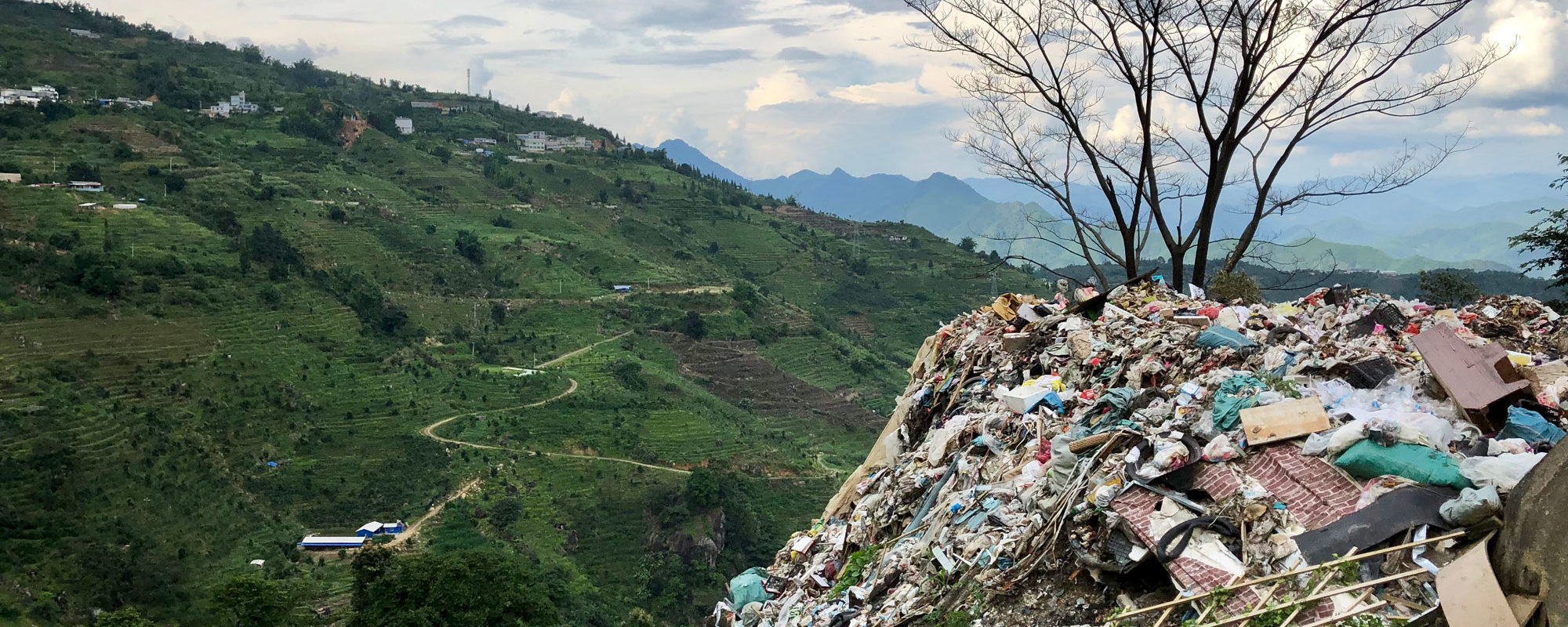Xigui, China — Little Tao said we’d return by eight o’clock in the morning at the latest.
“That gives us enough time, right?” asked my buddy Dave Hicks, an American who was visiting from Shanghai and mindful of his flight back the next afternoon.
“Cha bu duo,” I replied with a smile. The common phrase captures with precision the Chinese embrace of imprecision—where English equivalents such as “more or less,” “just about,” or “good enough” fall short.
I ordered navy. How come this is black?
Cha bu duo.
Does your car have enough seatbelts for everyone?
Cha bu duo.
You put sausage on my vegetarian pizza.
Cha bu duo.
I did figure we’d get back to the wharf a bit late. People in the countryside are not known for being overly conscientious about time. Nor am I. So I thought eight in the morning would be more-or-less just-about good enough. Cha bu duo.
My friend Little Tao is a fisherman. He lives with his wife and two kids at a small wharf on the Lancang River just before it runs into the Dachao Mountain Dam. (The Lancang River is known as the Mekong once it flows outside China). Four or five nights each week, Tao loads up his nets on a long flatbed boat and points the rusty bow upriver in search of fish.
Hoping to give Dave one last China adventure before his imminent return to the United States for graduate school, I had called Tao to ask whether we could tag along for an evening. “Of course!” he hollered into the phone. “Come by this afternoon and we can be back by morning for your flight.” Not being overly time-conscientious also means people in the countryside are overly hospitable and ever-adaptable. That is the formula for China adventures.
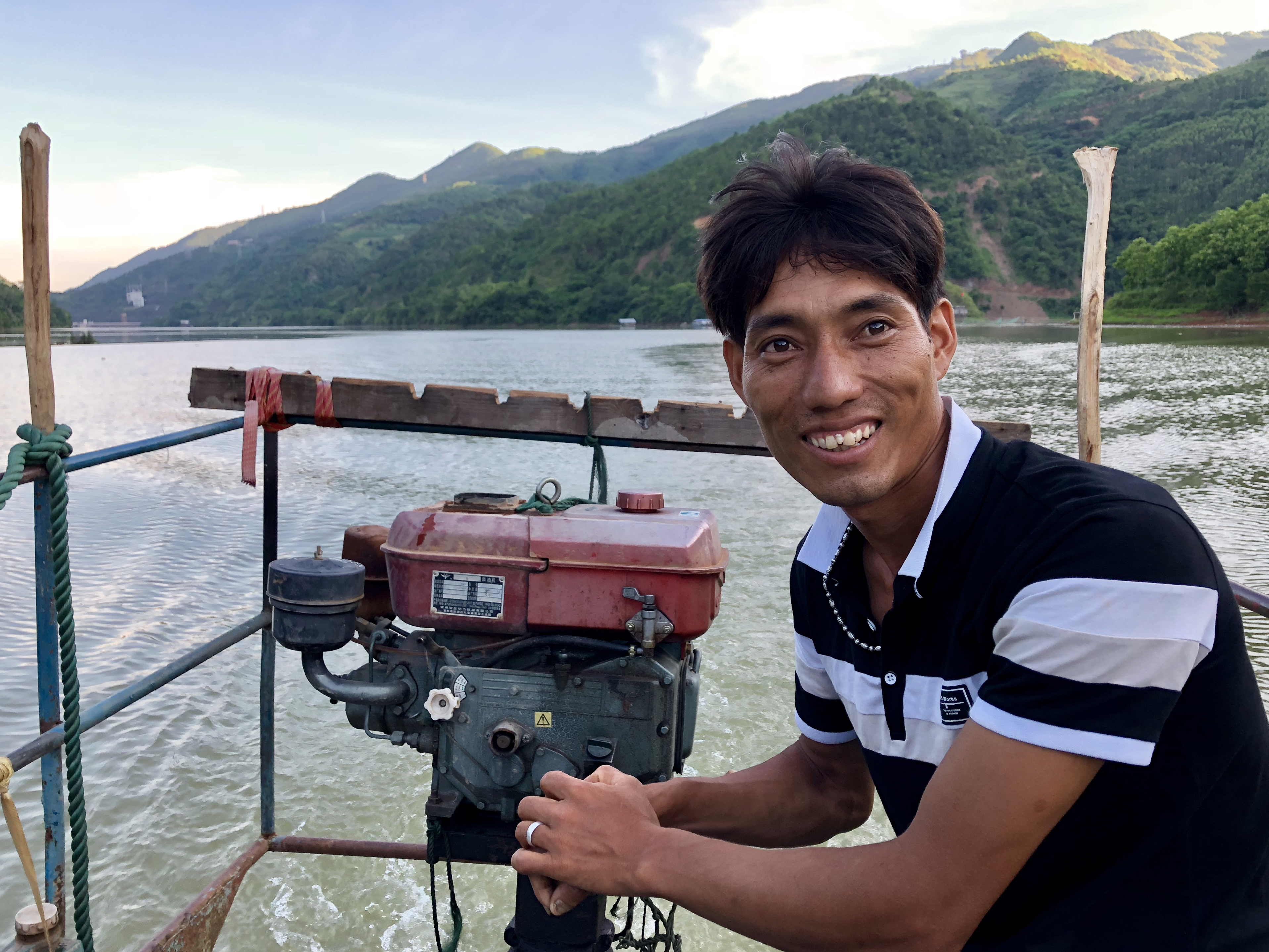
Little Tao is a fisherman on the Lancang River in southwest China
Dave and I arrived at the wharf just after dinner. Little Tao’s boat was loaded and ready to go so he started up his Changfa-brand outboard motor and headed upriver. The Lancang runs wide and slow, reflecting a deep green from the mountains all around. The eastern bank is a mess of lush tree overgrowth and vines that creep to the water’s edge. Black bears and monkeys roam free so, for overnights, Little Tao carries a rifle just in case. The western bank is bare, green but with scattered tree growth and an occasional homestead. “That’s the difference between government-owned land and privately owned land,” Little Tao explained. “The western bank is privately owned so most growth has been cut and sold.” And more changes are to come, he added. A few months ago, he brought a provincial leader upriver to scout sites for a tourism development plan. The bare mountainside is slated to host roads and hotels as tour boats run up and down the river. Little Tao hopes to benefit from the increased traffic, but he also wonders about the changes it will bring.
Back on the river, the trash was sparse at first. A familiar green bottle floated by with a yellow cap that read 雪碧, meaning snowy green jade—also known as Sprite. Next came the 神牛, or divine bull, a golden half-sized can and unapologetic copy of Red Bull. As we moved upriver, the garbage multiplied: plastic bottles, chunks of Styrofoam, aerosol cans, shoe soles, shampoo containers and detergent bags all tangled in a mess of driftwood. Eventually it stretched across the width of the river, a floating garbage patch hundreds of feet wide and several hundred feet long. Little Tao slowed the motor, veering toward a narrow passage along the eastern bank. “The floods came two months ago,” he explained, as if reading our horrified minds. “And with the rain came the trash.”
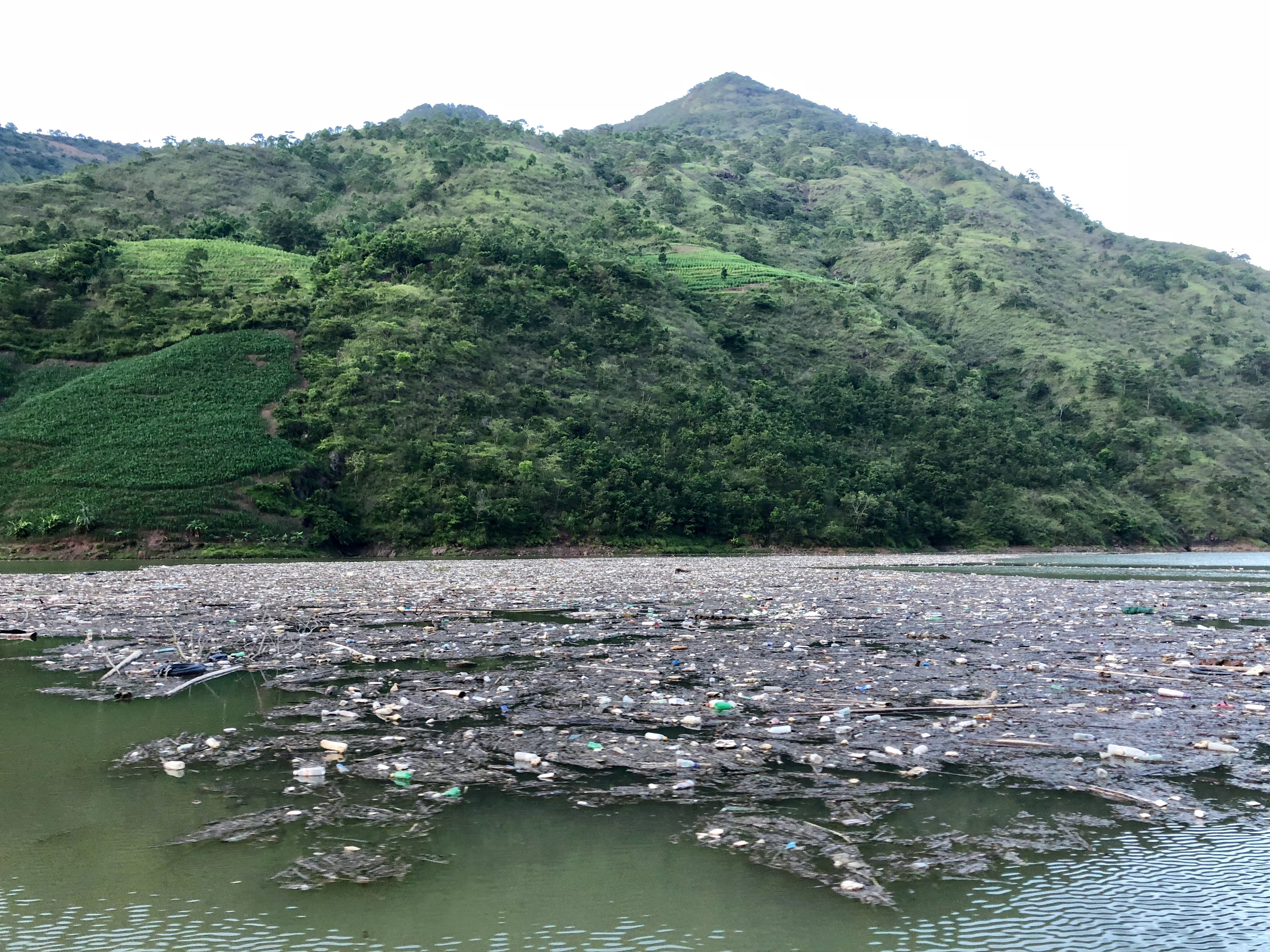
Garbage floats on the surface of the Lancang River. Plastic bottles, food packaging and Styrofoam comprise the majority of the trash
Nearby villages deal with trash in two ways: burning or dumping. Most villagers use open-air burn piles and dump remaining trash “in places no one sees so it doesn’t bother anyone,” as one villager told me. That includes in the forest, among piles of rocks, or, most commonly, down ravines and water gullies. Floodwaters sweep the trash from those hiding places down into the Lancang River below.
“Dealing with trash is my biggest headache,” says Zhu Hong, the mayor of Bangdong village, where I live in southwest Yunnan Province. “But mei ban fa,” he concedes: “there’s just nothing we can do about it.” Zhu Hong understands the threat trash poses to Bangdong. He has read about the toxic chemicals and carcinogens released into the environment when villagers burn their drink bottles and plastic bags. He knows those pollutants contaminate the soil, water and air, and can affect the quality of tea, which drives Bangdong’s economy. Zhu Hong also knows tourists are not drawn to trash-filled gullies or floating garbage patches.
Most villagers in Bangdong, however, have no sense of the impact trash has on their livelihoods. “We have lots of good air here so the burning doesn’t affect it,” one told me. “Just like that, the trash goes away and the air goes back to normal.”
It’s easy to look at trash-filled gullies and smoking burn piles and shake my head with disapproval. But it’s hard to be environmentally friendly, I’ve discovered, when there’s nothing you can do about it. Mei ban fa.
A resident on the river catches a ride with Little Tao back to the wharf in order to purchase supplies
Reduce, reuse and repent
In Bangdong village, I live in a mud-walled house built in the 1970s. Thanks to poverty elimination funding from the central government, my landlord-turned-neighbor built a new three-story concrete house and abandoned his mud-walled home next door. Along with it, he left behind heaps of clothing, cases of empty beer bottles, scraps of wood and metal, a broken rice cooker and a pile of chicken eggs complete with mother hen. These furnished my new home.
As I cleaned up the place and prepared to move in, the trash piled up. One day, a local friend assisting me with renovations also helped dispose of the trash. He lit a fire and threw on the feed sacks full of cardboard, plastic and Styrofoam. The smoke rose pure black against the clear blue sky. “Just like that, the trash goes away and the air goes back to normal,” I tried telling myself.
Guilt-ridden, I lugged a feed sack full of leftover beer bottles to the convenience shop down the road for recycling, penance for my environmental sins. Once or twice a month, a small truck visits our village and hauls away empty beer bottles for rebottling. That day, however, I learned that only our local Little Whirlwind beer recycles its bottles. Other brands like Lancang River and Dali do not, so I was left with three empty glass bottles in hand. “No worries,” the shop owner said, “you can throw them in the gully over there,” pointing to a curve in the road.
‘Rural trash management is a misnomer… It’s really just trash relocation.’
I looked down the steep embankment to a trickle of water below. The hillside was littered with the usual suspects: soda cans and water bottles, yogurt cups and plastic bags, glass vials of medicinal vinegar, ragged clothing, widowed shoes and sandals, a dented frying pan, a glassless welding mask and a rusted bicycle. From the stream below sprang a grove of bamboo. On the opposite hillside stretched spring-green tea terraces. I turned, bottles in hand, and returned the way I had come.
“You didn’t throw them?” the shop owner asked.
“If I throw them, they’ll be there for 100 years,” I replied with subtle righteous indignation. “It’s not good for the environment. If we ruin that, we ruin our tea and our tourism. Then what does Bangdong have?”
“Mei ban fa,” he shrugged. “There’s nothing we can do about it.”
I returned to my house vindicated but conflicted. Placing the bottles in a trash bag, I looked at my friend and said, “I’ll think of another way.” He just nodded. Soon after, I noticed him heaving the bag over his shoulder and making his way down to the gully. I didn’t stop him. My hypocrisy rang out as clearly to me as a cock’s crow to the apostle Peter.
But other than burning and dumping, what else can be done about the trash? There seemed to be just one answer: mei ban fa. Several years ago, the local government outfitted rural villages with incinerators as a solution. There was little uptake, however. Trash had to be dried and meticulously sorted so operating the incinerators proved a hassle and there was no funding for someone to maintain them. Most important, perhaps, there was no buy-in from the village from the onset. Bangdong’s incinerator has never been used to this today. Ours and other incinerators from surrounding villages litter the roadsides, 15-foot monuments to a failed campaign.
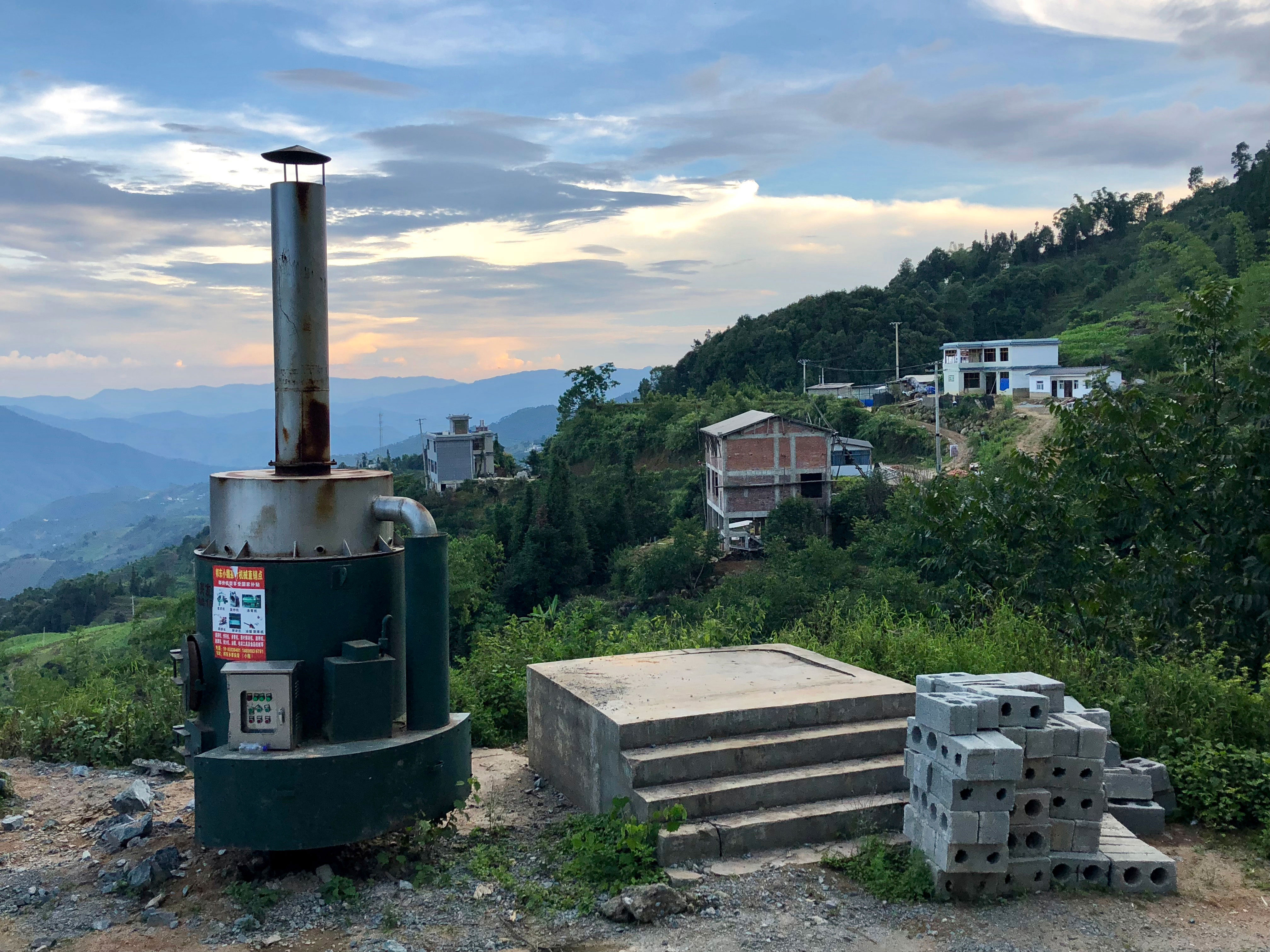
An incinerator stands unused by the roadside. The government supplied villages with incinerators to manage trash, but very few are actually used
The trash problem is hardly unique to Bangdong; rural areas across China face similar challenges. In recent years, the government has tried a new strategy called “village collection, township transfer, and county treatment.” Similar to urban waste management, trash is collected locally, consolidated at regional nodes, and then transported to central treatment facilities. While that effort has had some successes, a study last year by Stanford’s Scott Rozelle and academics from a number of Chinese universities identified some of the challenges still facing the approach. Villages lack trash collection facilities such as dumpsters and waste pits. They also lack funding for workers to collect trash or vehicles to transport it to townships. And many villages report an absence of supervision by upper-level officials, which contributes to poor implementation. Ultimately, only 22 percent of villages in a nationwide sample had waste disposal services.
And the problem of rural waste is only growing—by about 8-10 percent each year in rural China, to be precise. As rural infrastructure improves and incomes rise, myriad new products—along with the waste they create—are flooding the markets. Rural waste in China reached over 500 million pounds per year in 2010, exceeding urban waste for the first time. Still, no successful model for rural trash management exists today.
“Rural trash management itself is a misnomer,” Mao Da corrected me by phone. “It’s really just trash relocation.” He is the founder of China Zero Waste Alliance and a leading expert on waste management in China. “The problem in rural areas is that they are trying to use an urban model of trash management—collection and mixed-waste dumping—which is itself a failure. Using this model in the countryside,” he continued, “is adding failure upon failure.”
The nearby township of Potou is so mountainous, there is no place large and flat enough to construct a landfill. Instead, trash is collected and just dumped down the mountainside on the outskirts of town. Needless to say, no measures are taken against the leakage of toxic pollutants or for air emission control. After four years of trash build-up, the local government simply built a wall to prevent further dumping and started a new dumpsite about a mile away. Trash at the new site already spills down the mountainside.
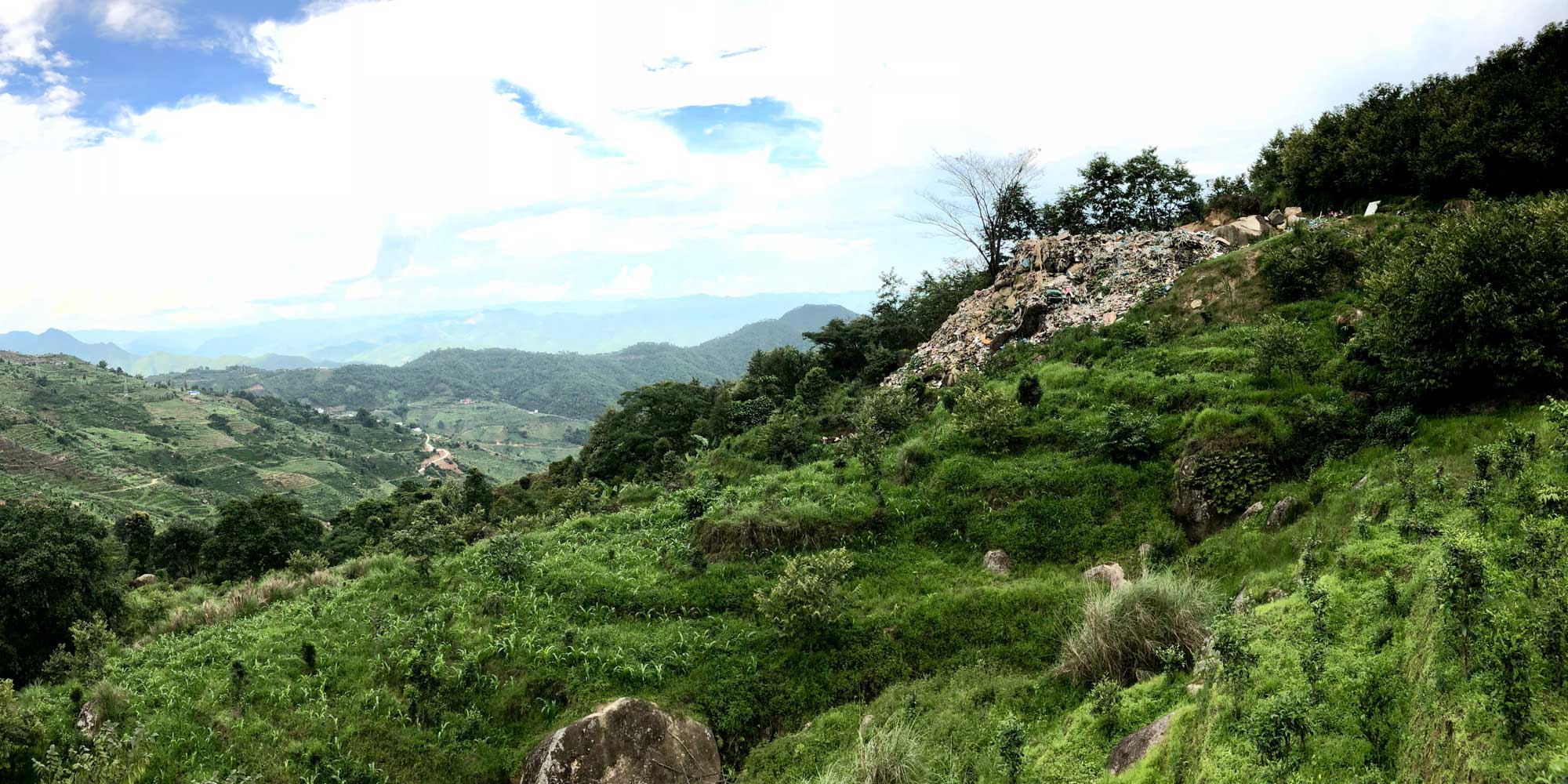
The new “landfill” in Potou
“What we need are concrete examples of successful trash management at the village level to share with the central government,” Mao Da said. “It’s easy to criticize, but difficult to find implementable solutions.”
Implementable solutions are exactly what Chen Liwen is trying to find. After years of environmental activism and then earning her Masters in Canada, she returned to her home village last year to set up a trash-management pilot program. “Most locals don’t understand why a big-city and overseas-educated girl would come back to the village, let alone work with trash,” she told me by phone in fluent English. But the decision was personal for Chen. In a Chinese article profiling her, she describes a pool where she used to play as a girl: “We would splash in the water in summer and skate in winter… but that pool has become our village trash dump. I want my pool back.”
After three months, Chen was able to reduce village waste by 80 percent. Two colleagues are now implementing pilot programs in other villages following the same model. Chen says separating compostable items, recyclables and trash is the starting point. “But the key to success is localizing practices to each village,” she tells me. “How and when should you collect so it’s convenient for villagers? What items are recyclable? How can you teach villagers to sort?” It’s actually quite easy to change the behavior of farmers compared with city-goers, she says. “It’s a community, so people know and influence one another. And the head of the village still holds authority. Basically, he can still tell people what to do.”
Sustainable financing and oversight remain challenges, but Mao and Chen are both optimistic. Mao points out that central policy on the environment did not extend to the county level until two years ago, leaving local governments in charge—and making a mess—of waste management. However, the central government has recognized that and in the last two years has started to work with local leaders on rural trash management, and hold them accountable. Chen also points out that with the central government focused on poverty elimination efforts and rural revitalization, there is more money available for waste management in rural areas.
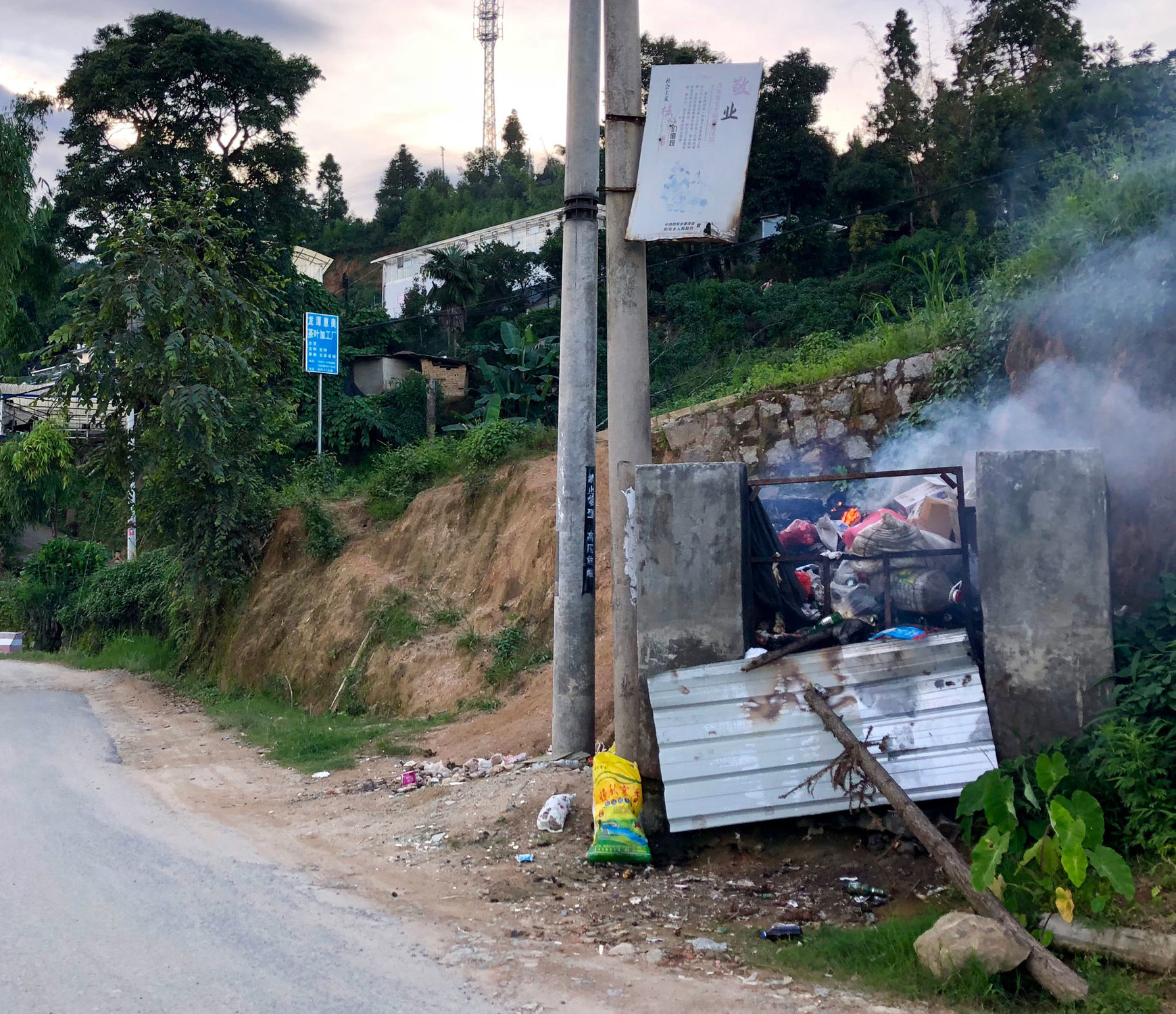
Villagers deposit and burn trash in concrete pits like this one on the road to Bangdong
It seems we’re seeing the change come to fruition in Bangdong village. I sat down with Zhao Suo, who oversees trash management for the entire township. “In the next couple months, we are starting a new trash management program,” he told me over a cup of tea at the village committee center. Families will burn what they can and then separate the remaining trash into “life waste” (cardboard, food scraps, fruit peels) and “production waste” (bricks, rebar, metal). Life waste is collected in oil barrels provided by the government and transported to a nearby landfill once per week, while production waste is left to families to transport to the landfill on their own. They pay roughly $0.50 per month for the service. “It covers only about 70 percent of the cost, but we think it’s important they are financially invested in this,” Zhao says. “The government will supplement the rest as we gradually make it self-supporting.”
But the plan concerns me. “I don’t know much about waste management,” I began delicately, “but it’s disconcerting that plastic is still being burned and recyclables aren’t being separated. I’m afraid people will just dump the production waste in gullies like they’ve been doing.”
“We know the plan isn’t perfect,” Zhao replied with the diplomatic equivalent of cha bu duo. “But we have to start somewhere, with something simple, so villagers can accept it. Then we’ll make it better as we go.”
Without a paddle
Dave and I rose at dawn to the river on fire. The water glowed red with the morning sunlight and mist rose like smoke. We’d had an eventful evening with Little Tao and his river friends, a boatful of whom brought a comb full of fresh wasp larvae that our hosts turned into soup. (Wasp larvae have a satisfying mouth burst, like protein-packed Gushers fruit snacks.) But we rose early to gather up the nets and get back to the wharf. Dave had a plane to catch.
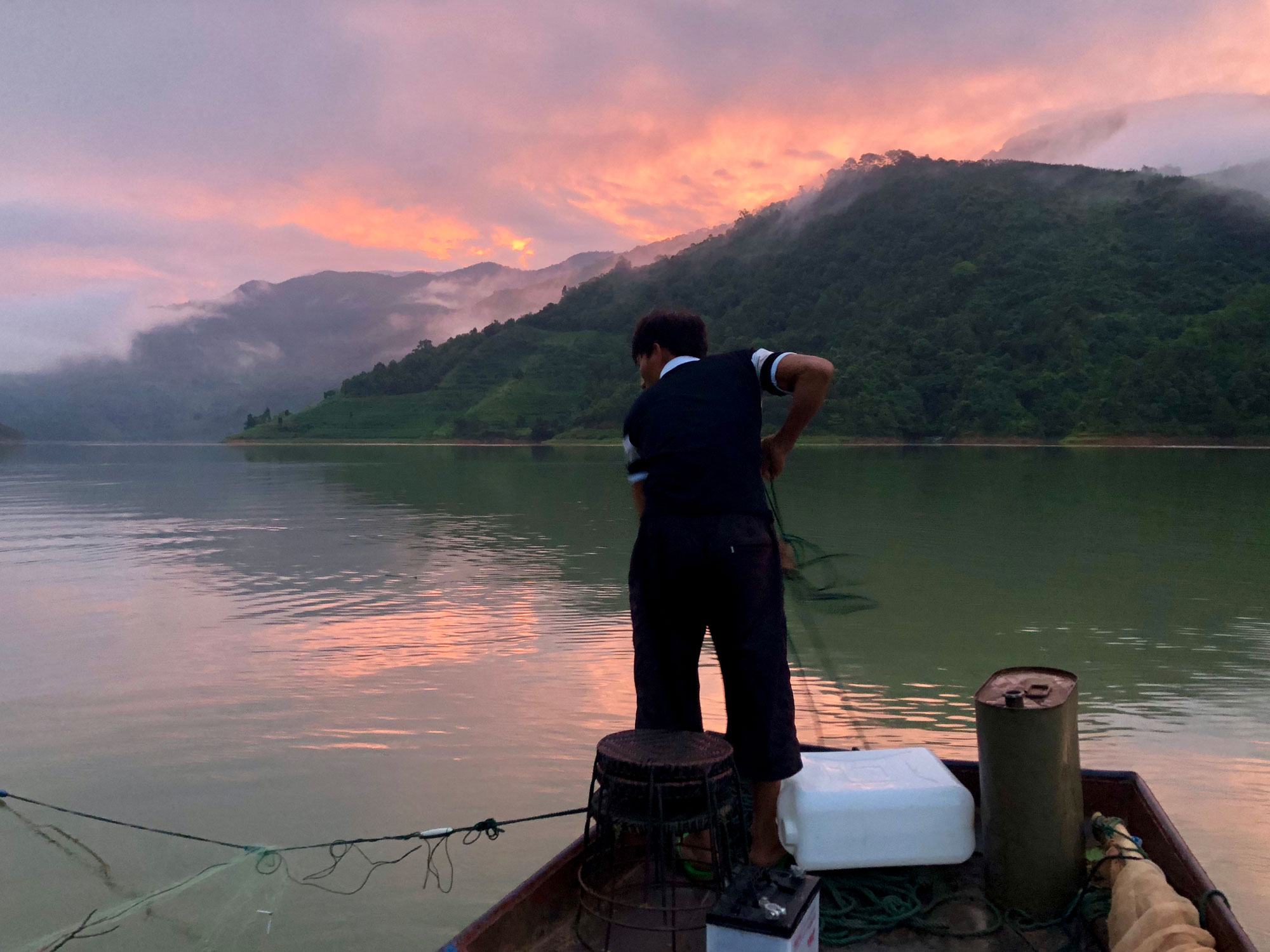
Morning on the Lancang River as Little Tao checks his nets for fish
Little Tao collected his nets quickly and mechanically, like someone who had done it a thousand times. But after the first net, it was already 7 a.m. “Little Tao,” I asked, “we’re still going to be able to be back to the wharf by eight, right?”
“Cha bu duo,” he responded. Dave shifted uncomfortably.
At 8 a.m., we were just getting the last net in the boat. And by 9 a.m., I was shifting uncomfortably. The margin time I’d factored in was now completely gone.
I was doing worst-case-scenario recalculations in my head when the boat slowed. We were approaching the floating garbage patch and Little Tao began navigating through the trash. Flight at 2:35pm… Lincang to airport… Bangdong to Lincang… wharf to Bangdong… I worked backward. “It’ll be tight, but we can still make it,” I assured Dave.
And then the motor died. Little Tao hoisted it out of the water and up came a heap of wire, zipper, shredded suitcase and a shoe. The propeller was entangled in the mess and locked tight, no match for the floating garbage patch. Now flustered, Little Tao went to work on the knot of metal as I began recalculating. Flight at 2:35pm… Lincang to airport… “Mei ban fa,” I told Dave, conceding defeat. “We’ll have to change our flight.”
But Little Tao worked efficiently and it wasn’t long before the diesel outboard motor was chugging downriver again. Shortly before 10 a.m., we finally reached the wharf. We thanked Little Tao and raced for our ride, declining his generous insistence that we stay for breakfast: “My wife has already made it! You must eat!”
Dave and I watched the clock and recalculated during the entire three-hour drive into the city. When we switched vehicles in Lincang, we were still 12 miles out and only 45 minutes from departure time. “No problem!” our taxi driver exclaimed. “The new airport highway just opened six months ago.”
It was a nine-minute ride on an empty expressway. Dave and I rushed into the airport and up to the check-in counter only to be greeted by a “CLOSED” sign. “Are we too late?” I asked the attendant, my heart bracing for mei ban fa. He smiled at us and casually turned the sign around to read “WELCOME.”
“Cha bu duo,” he said.

